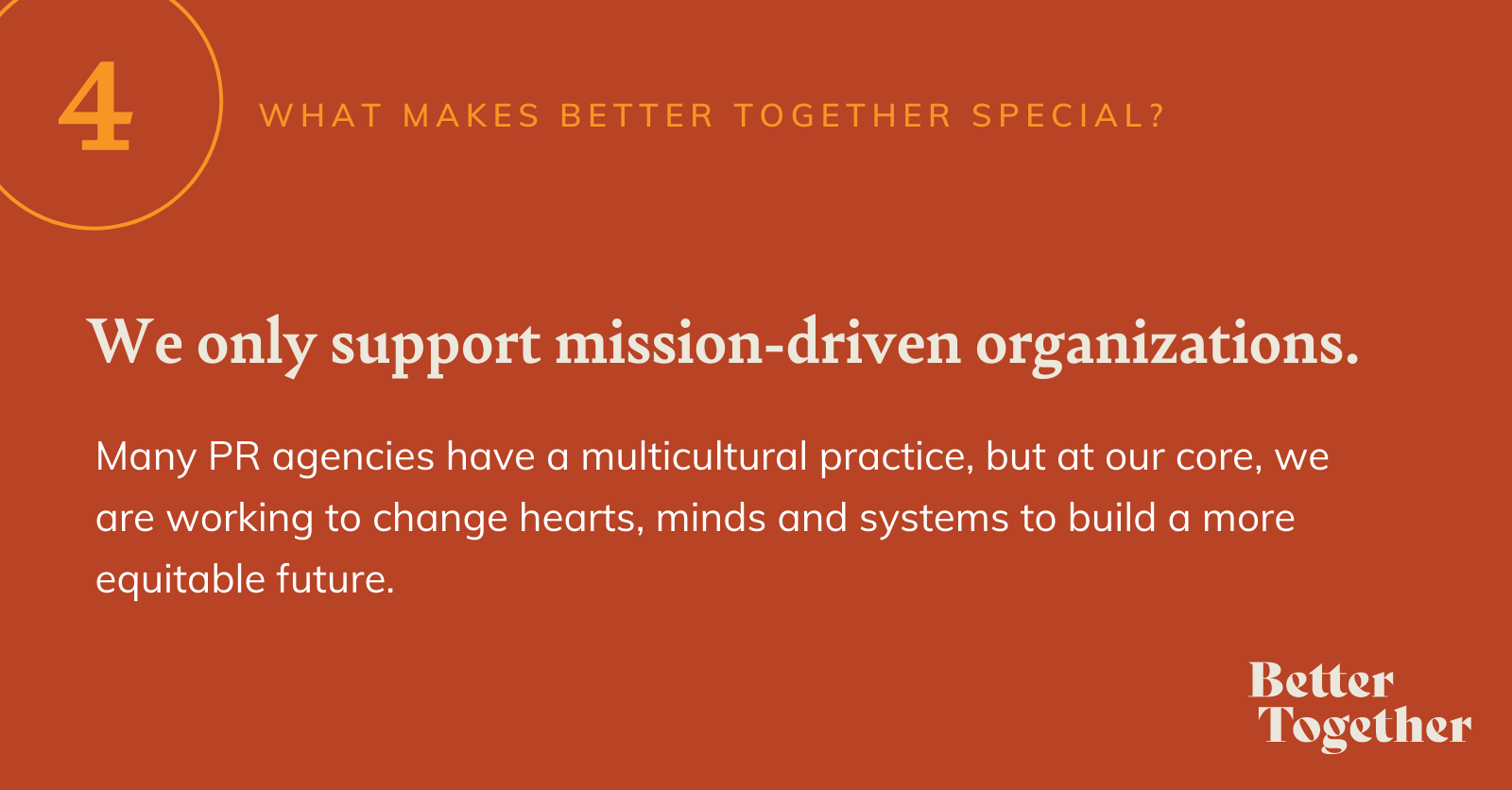
Aligning Purpose and Profit Isn't Just a Nice Idea—It's Helping Me Build a $500,000 Per Year Business
Succeeding as an entrepreneur is never easy—succeeding as a social good business is even harder. Learn how this first-time business owner made it happen.
Founder of Better Together
In my long career before starting a company, I’ve experienced all kinds of businesses. I worked for well-known agencies that were doing splashy, exciting work—but for corporations that weren’t necessarily making a positive impact on the world. I’ve also seen companies who claim to be mission driven—but refuse to take a true stand or align their internal culture with that purpose.
When I stepped into starting my own company, I felt there had to be a better way. I wanted to lead an agency that was doing impactful work, that was actually helping people, and that was financially successful. That couldn’t be all that hard, right?
Not quite.
Building a thriving company is never easy and building one with integrity makes it even more challenging. But, while there have been ups and downs since I launched Better Together in January, I have verified that it is possible to chase purpose and profit at the same time—and succeed at both. Even while solely working with purpose-driven organizations, my agency has hired five full-time employees, was able to get our client featured in The New York Times, and is on track to make hundreds of thousands in our first year.
For any other business owner trying to figure out how to simultaneously do good and make money, here are four strategies that have helped me.
I keep us accountable to the clients we want to work with
Especially in the early days, it can be so tempting to take any client work that comes your way. But one of the keys to my business success is understanding our mission from the start and being diligent about only taking on work that aligns with that mission.
Sticking to our mission of using communications to achieve equity helps us differentiate ourselves from other agencies, as there aren’t many that focus solely on social impact and certainly not ones that have the same skills as we do to back it up with great work. People get excited when I tell them about the mission of Better Together, I get excited talking about it, and this passion drives clients toward working with us. These conversations wouldn’t be as impactful if we were wishy-washy in terms of what we do and who we serve.
Have I been tempted to waver from the mission when a non-social-impact client comes along offering us all of the money? Of course, I have. I’ve considered doing it just this once, or carving out time on the side. But I never have because, while that might feel like a short-term win for the business, it ultimately would take time and resources away from the work we want to be doing and muddle our messaging by putting the wrong type of work in our portfolio.
Now, to help hold ourselves accountable, we have a proverbial checklist of requirements an organization must meet if we’re going to work with them: authenticity, awareness, and the ability to admit when an organization hasn’t done everything is right are vital traits for partners that align with our mission. This helps us ensure we’re not just going after profit, but sticking to our purpose, too. But it also hasn’t slowed down our profit too much: With so much unfortunate tragedy in the world these days, there are plenty of companies that need communications support around social justice topics.

I pass on clients if our budgets don’t align
Another common challenge for social good businesses is wanting to support organizations that are doing important work, even if they don’t quite have the budgets for your usual rates.
I definitely did this at first, taking any client that was exciting to me even if the work itself was undervalued. But I quickly learned that, while this initially feels good from a mission perspective, it hurts the business in the long run. Often the clients paying you the least expect the most from you, because they feel they are expending so much of their limited resources to work with you. We’ve definitely over-serviced some of them to make sure they’re happy with the work, which takes time and energy away from the clients who are able to pay what we’re worth.
Ultimately, I’ve realized that if the budget isn’t aligned, neither one of us is going to be successful. To avoid setting ourselves up for failure in the future, we’ve adjusted our pricing to understand the lowest we can go and still deliver the quality of the work we want to—and, unfortunately, have to turn down clients we’d love to support if that budget can’t be met. The ultimate goal is for us to work with higher-dollar partners who can support us enough that we have space to work with some lower-budget clients who are having an impact.
I take a stand in our own communications, too
I don’t think we can help other organizations advocate for social change and not be willing to do it ourselves. And yet, I’m constantly shocked how many mission-driven organizations won’t speak out about the causes they care about because they’re too afraid of alienating potential customers.
On the contrary, putting ourselves out there about the causes we care about is exactly how we’ve been able to find the right customers to work with. We aren’t afraid to take to our social channels to talk about anything from our stance on the Supreme Court decision about affirmative action to Black power and critical race theory. Sure, this will certainly alienate some people, but if that’s the case, we wouldn’t want to work with them anyway. Meanwhile, we’ve reaffirmed our mission and passion to the kinds of clients we do want to work with. I’ve had several organizations—from small nonprofits to Fortune 500 companies—reach out to me via LinkedIn because of the posts we promoted or articles we have written. Partners gravitate toward our way of communicating and see how we could make a difference for them.
To succeed as a social impact company (or even perhaps a company in general), it’s important to be up front about your values and be comfortable that they won’t align with everyone.
I make sure we’re not just doing good, but are also a good place to work
I believe our mission to build a more equitable world has to be reflected in our workplace culture. I’ve worked for “social good” organizations in the past that looked the other way when I experienced racism in the workplace. To me, succeeding as a business not only means making money but doing it while living out our values with our employees.
That’s why I regularly check in with my team about what we can be doing better as a company. I even have a daily task in Asana to take some time to think about the employee experience, whether that’s just Slacking everyone “good morning” to make sure they feel supported or thinking more deeply about how I can build a culture that is inclusive for all.
It’s so easy to get lost in the daily grind and forget about this piece of the mission, but when you’re intentional about making sure it’s reflected in everything you do, that’s when you’ll build a business that is not only successful financially, but that is successful in contributing to the world you want to be a part of.
Try Buffer for free
140,000+ small businesses like yours use Buffer to build their brand on social media every month
Get started nowRelated Articles

Sending ads by mail may seem like a thing of the past, but this marketer thinks it’s a surprisingly effective approach for e-commerce brands.

In this article, we'll explore the unique characteristics of organic and paid social media, how they complement each other, and why incorporating both into your social media strategy is essential for achieving your business goals.

Whether you’re a full-time content creator, micro-influencer, nano-influencer, or just getting started, here’s how to create your own influencer media kit.